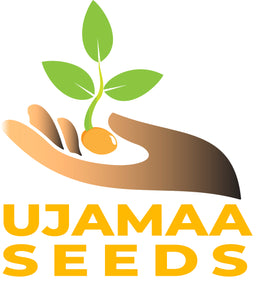Georgia Rattlesnake Watermelon
Citrullus lanatus
Seeds per pack ~20
Germination: 97% Nov 2024 (Packed for 2025)
Origins and History
The Georgia Rattlesnake Watermelon (Citrullus lanatus) is a classic Southern heirloom variety that dates back to the mid-19th century, with documented cultivation beginning around the 1830s in Georgia. It earned its colorful name from the distinctive, snakelike green stripes that ripple across its light green rind. Widely grown in the American South for generations, this variety was especially prized by farmers and home gardeners for its exceptional size, sweet flavor, and ability to thrive in hot climates. Its enduring popularity reflects both its reliable performance in the field and its cultural significance as a summertime staple in Southern agricultural traditions.
Appearance and Characteristics
Georgia Rattlesnake Watermelons are large and oblong, often reaching 25 to 35 pounds when fully mature, and sometimes exceeding 40 pounds under optimal growing conditions. The rind is pale green with dark green wavy stripes that resemble the pattern of a rattlesnake’s skin—hence the name. Inside, the flesh is a brilliant, juicy pink-red, flecked with small black seeds. This variety is known for its crisp texture and high sugar content, which contributes to its rich, refreshing flavor. Its thick rind also makes it ideal for storage and transport.
Culinary Uses
Celebrated for its juicy sweetness, the Georgia Rattlesnake is perfect for slicing and eating fresh on hot summer days. Its large size makes it ideal for picnics, family gatherings, and community events. The flesh can also be cubed and added to fruit salads, blended into watermelon juice, or frozen for smoothies and sorbets. The rinds, true to Southern tradition, can even be pickled to create a tangy, crunchy treat. Its intense color and flavor also make it a standout ingredient in chilled soups and summer desserts.
Growing Tips
This heat-loving watermelon thrives in full sun and well-drained, sandy loam soil with a pH between 6.0 and 7.5. Direct sow seeds in the garden after the danger of frost has passed and soil temperatures are at least 70°F. Plant in hills or rows, spacing seeds about 3 to 4 feet apart with rows 6 to 8 feet apart to allow for vigorous vine growth. Georgia Rattlesnake benefits from ample organic matter and consistent watering, especially during flowering and fruit development. Mulching around the base can help retain soil moisture and suppress weeds. Bees are essential pollinators, so avoid insecticides during bloom.
Harvesting Guidance
Georgia Rattlesnake Watermelons typically mature in 85 to 95 days. To determine ripeness, look for a creamy yellow spot on the underside where the melon rested on the ground, and check that the tendril closest to the fruit has turned brown and dried up. A ripe watermelon will also sound hollow when thumped. Use a sharp knife or pruners to harvest, leaving a few inches of stem attached to the fruit to extend shelf life. Once picked, these melons can be stored in a cool, shaded area and enjoyed over several days, bringing a true taste of Southern heritage to your table.
Watermelons were first cultivated in Africa before spreading north into Mediterranean countries and, later, to other parts of Europe. The transatlantic slave trade was the main vehicle by which the watermelon made its way to the Americas. Before it became a racist stereotype in the Jim Crow era, watermelon once symbolized black self-sufficiency. After the Civil War, newly freed African Americans grew, ate and sold watermelon—the fruit became a symbol of freedom
NUTRITIONAL VALUE: Watermelon is predominantly composed of water, aiding in maintaining proper hydration levels in the body. Beyond its thirst-quenching properties, it is a rich source of vitamins, particularly vitamin C, which supports the immune system and promotes skin health. It also contains vitamins A and B6, contributing to vision and metabolic processes. Watermelon's vibrant red hue signifies the presence of the antioxidant lycopene, linked to potential health benefits, including heart health and reducing oxidative stress. The fruit is naturally low in calories, making it a guilt-free option for those watching their calorie intake. Additionally, watermelon provides essential minerals such as potassium, crucial for maintaining electrolyte balance and supporting proper heart function.
FOOD PREP: The most popular way to eat watermelon is to slice the watermelon into wedges or cubes, providing a convenient and mess-free way to enjoy this hydrating fruit. For a twist, consider making watermelon skewers by threading the cubes onto sticks and alternating with other fruits like mint or feta cheese for a delightful appetizer. Turning watermelon into a chilled soup or gazpacho offers a unique and cooling option on warm days. Additionally, blending watermelon into smoothies or juices provides a refreshing beverage bursting with flavor. Experiment with savory combinations by adding watermelon to salads with feta, mint, and balsamic glaze for a sweet and savory contrast. Frozen watermelon cubes make for a healthy and tasty snack while incorporating the fruit into sorbets, popsicles, or granitas adds a playful touch to desserts. The seeds of a watermelon are also considered a culinary delight, with a slightly nutty flavor.



